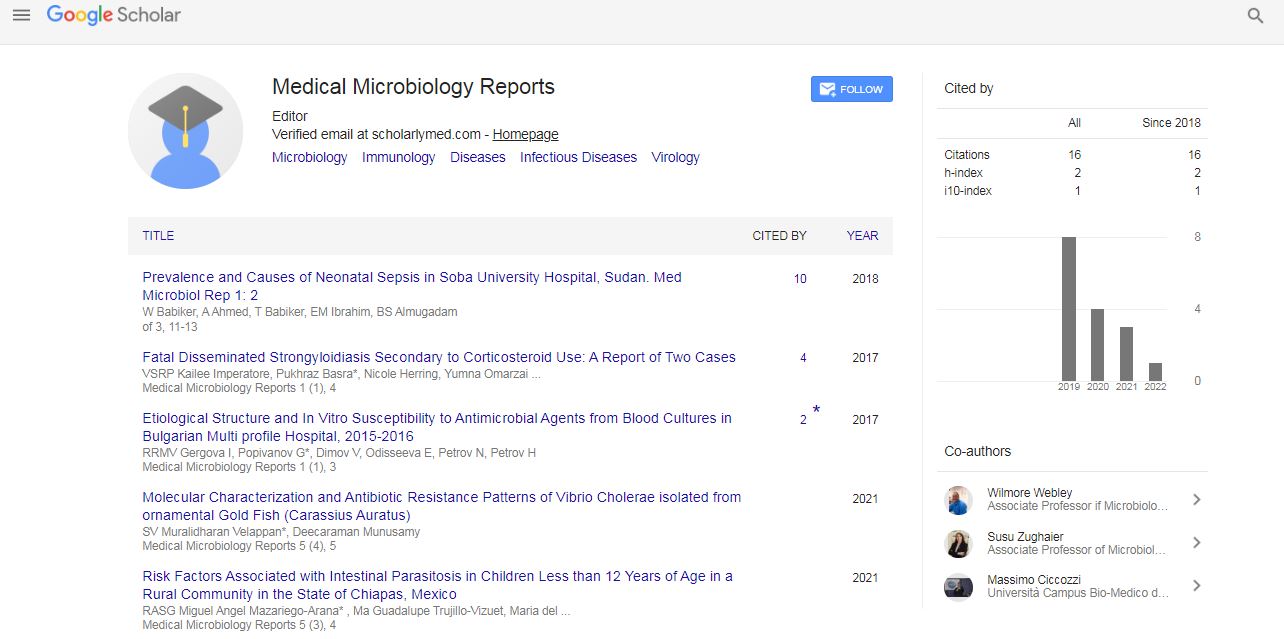Commentary, Med Microbiol Rep Vol: 6 Issue: 1
Pseudomonas Aeruginosa Inside the Healthcare Facility
Madison Grants*
Department of Microbiology, Lund University, Lund, Sweden
- *Corresponding Author:
- Madison Grants
Department of Microbiology, Lund University, Lund, Sweden
E-mail:madisong@yahoo.com
Received date: 05January, 2022, Manuscript No. MMR-22-58176;
Editor assigned date: 11January, 2022; Pre QC No. MMR-22-58176 (PQ);
Reviewed date: 20January, 2022, QC No. MMR-22-58176;
Revised date: 28January, 2022, Manuscript No: MMR-22-58176 (R);
Published date: 04February, 2022, DOI:10.4172/mmr.1000312
Citation: Madison G (2022) Pseudomonas Aeruginosa Inside the Healthcare Facility. Med Microbiol Rep 06:01.
Keywords: Antibiotics; Pseudomonas; Pathogen; ICU
Abstract
Pseudomonas aeruginosa is a gram-terrible pathogen that has become an essential reason of infection in humans and may be related to full-size morbidity and mortality. Excessive infections generally affect immune compromised sufferers or those with persistent debilitating sicknesses. Its importance as a pathogen is exacerbated by way of its resistance to antibiotics, virulence elements and its ability to adapt to a huge variety of environments. P. aeruginosa can have multiple intrinsic or obtained mechanisms of resistance, regularly with high resistance charges to numerous antimicrobial classes. In recent years, the global unfold of the so-referred to as 'excessive-threat clones' of multidrug-resistant or notably drug-resistant P. aeruginosa has turn out to be a public health hazard that needs to be studied and controlled with urgency and backbone.
Keywords: Antibiotics; Pseudomonas; Pathogen; ICU
Introduction
Pseudomonas aeruginosa is a Gram-terrible pathogen that has grown to be a crucial reason of contamination in human beings and can be related to sizable morbidity and mortality. This microorganism is one of the maximum common and excessive reasons of hospital-received infections, especially affecting immunocompromised (in particular neutropenic) and Intensive Care Unit (ICU) patients. The majority of P.aeruginosa traces are resistant to maximum antibiotics currently in use. Due to a variety of mechanisms for version, survival and resistance to more than one training of antibiotics, infections by means of P.aeruginosa traces may be existence-threatening and are rising as a global public fitness threat [1]. The intention of the prevailing narrative overview is to describe P.aeruginosa within the healthcare facility settings, and the related infectious threat. P.aeruginosa bacteriology, ecology, healthcare reservoir, healthcare infection, prevention and control measures. Only that it assessments as "touchy to" at the way of life record. Because bacteria broaden resistance to antibiotics fairly regularly, and the stress the affected person has might be one of these [2,3]. You received understand without an "S and S" (Subculture and Sensitivity) check, which takes several days. First they grow the micro-organism from the website online of infection in a nutrient solution, and then they check it with antibiotics to look which of them inhibit that precise pseudomonas [4]. Certain, you may begin an antibiotic routine (more than one antibiotic) that normally used for it while you watch for sensitivity reports. E-remedy suggests an "anti pseudomonal beta-lactam (e.g., penicillin or cephalosporin) and an aminoglycoside (tobramycin, gentamycin, etc., given via IV). Carbapenems (e.g., imipenem, meropenem) with antipseudomonal quinolones may be used at the side of an aminoglycoside."
Pathogen is Pseudomonas Aeruginosa
Pseudomonas aeruginosa is a bacterium this is determined in most guy-made environments within the international, favoring wet areas like soils or water. Pseudomonas translates from the Greek for 'fake' and Latin for 'unit', and aeruginosa derives from the Latin for 'verdigris' because of its blue-inexperienced shade in cultures. In small concentrations the bacteria is of no real risk to human beings, but it is able to be dangerous for the weak or immune compromised [5-7]. Signs of Pseudomonas aeruginosa rely upon where it is causing troubles since it is able to contribute to bloodstream infections, pneumonia, ear infections or urinary tract infections, among others.
Pseudomonas Aeruginosa be Avoided
P.aeruginosa is a gram bad micro-organism which could survive in varied environments and is a pathogen causing diseases in both vegetation and animals. Contamination in human may be deadly. This micro-organism is nosocomial (can be received from hospitals) and is likewise muti-drug resistant. 80% of patients with CF (Cystic Fibrosis) will have P.aeruginosa as it is an opportunistic pathogen. The excellent prevention to be had is to be smooth and stay smooth. A focal point on non-public hygiene could be very essential whilst using public baths, swimming pools and hot tubs. Specifically if any individual is immuno-compromised (bad immunity) then they need to take care of burns, cuts, wounds and keep away from blood infections. The bacteria enter the lungs thru mouth and nose. So keep away from direct and indirect touch with humans having CF [8].
Pseudomonas Aeruginosa Dealt
Pseudomonas aeruginosa is a gram poor microorganism. It is able to be handled with antibiotics like ceftazidime, cefipime, ciprofloxacin, levofloxacin, imipenim, tazocin and meropenem. It has to never be treated with first and 2D or oral 0.33 era cephalosporins. In existence threatening infections normally a mixture of above mentioned antibiotics is used, considering this bacteria is known to increase resistance very quickly. Among infections resulting from gram-bad rods, Pseudomonas aeruginosa has a main role, especially in severely unwell and immunocompromised sufferers. Antimicrobial resistance has brought about a critical limit in treatment alternatives for P.aeruginosa infections, which has become a crucial and deadly problem inflicting a total of 51,000 healthcare infections inside the U.S. in keeping with year [8,9]. Not with standing this problem, physicians in particular depend upon retrospective non-randomized managed research to derive conclusions about the finest therapeutic control of these infections.
In this evaluation, we aim to deal with decided on factors of P.aeruginosa antimicrobial resistance and infection control. In the first a part of this review, we are able to consciousness on resistance dangers elements. Many studies have been completed to assess the threat factors for resistance and the ability effects on mortality and attributable mortality. We can then explore the mechanisms related to resistance. P.aeruginosa is a pathogen providing a huge genome that may increase a huge range of things associated with antibiotic resistance involving nearly all classes of antibiotics. We will then mainly awareness on medical processes to patients with bacteremia, ventilator-associated pneumonia, urinary tract infections, and skin and soft-tissue infections. Specific syndromes along with ecthyma gangrenosum can be discussed [10]. In the 2nd part of our paintings, we will take a look at pharmacokinetic and pharmacodynamic parameters that can be exploited to optimize P.aeruginosa treatment. Boundaries of modern therapy, capability opportunity capsules and new healing alternatives can also be mentioned.
Reference
- Anaissie EJ, Penzak SR, Dignani MC (2002) The hospital water supply as a source of nosocomial infections: A plea for action. Archives of Internal Medicine 162: 1483â??1492.
[Crossref], [Google Scholar], [Indexed]
- Assadian O, Elâ?Madani N, Seper E, Mustafa S, Aspöck C, et al. (2002) Sensorâ?operated faucets: A possible source of nosocomial infection?. Infection Control and Hospital Epidemiology 23: 44â??46.
[Crossref], [Google Scholar], [Indexed]
- Zarb P, Coignard B, Griskeviciene J, Muller A, Vankerckhoven V, et al. (2012) The European Centre For Disease Prevention And Control (ECDC) pilot point prevalence survey of healthcareâ?associated infections and antimicrobial use. Euro Surveillance 17: 4â??19.
[Crossref], [Google Scholar],[Indexed]
- Wingender J, Flemming HC (2011) Biofilms in drinking water and their role as reservoir for pathogens. International Int J Hyg. Environ Health 214: 417â??423.
[Crossref], [Google Scholar], [Indexed]
- Wingender J, Flemming HC (2004) Contamination potential of drinking water distribution network biofilms. Water Science and Technology 49: 277â??286.
[Crossref], [Google Scholar], [Indexed]
- Warburton DW, Bowen B, Konkle A (1994) The survival and recovery of Pseudomonas aeruginosa and its effect upon salmonellae in water: Methodology to test bottled water in Canada. Can J Microbiol 40, 987â??992.
[Crossref], [Google Scholar], [Indexed]
- Rahman MS, Encarnacion G, Camper AK (2011) Nitrification and potential control mechanisms in simulated premises plumbing. Water Res 45: 5511â??5522.
[Crossref], [Google Scholar], [Indexed]
- Pillsbury D, Rebell G, De Saint Phalle M, Ginsberg D (1950) Factors affecting the rapid disappearance of bacteria placed on the normal skin. J Invest Dermatol 14: 247-64.
[Crossref], [Google Scholar]
- Jones S (2011) Hand hygiene and transmission of Pseudomonas aeruginosa on hands in a hospital environment. J Infect Prev 12: 146â??148.
[Crossref], [Google Scholar]
- Kristina DM, Charles PG (2009) Risk assessment of Pseudomonas aeruginosa in water. Rev Environ Contam Toxicol 201: 71-115.
[Crossref], [Google Scholar]
 Spanish
Spanish  Chinese
Chinese  Russian
Russian  German
German  French
French  Japanese
Japanese  Portuguese
Portuguese  Hindi
Hindi 
